This year’s Apple developers conference began with a generally well-received Keynote featuring its CEO, some well-known SVP presenters, and some new faces.
I choose to use Apple’s Keynote presentation software when I present, and it seems to still be the software Apple relies on for its major presentations.
Keen Keynote users like myself look to these keynotes not just to see the Apple pathway just ahead (major updates to all of its software operating systems) but to see if there are new features in Keynote being demoed, ones we might expect to see in a forthcoming update. This time I saw nothing new, or if there was it was not so glaringly obvious.
But something of interest to presenters did catch my eye. This was an app for the Applewatch called Breathe. It was demoed almost as a “one more thing” at the end of a long presentation about the new operating software for the watch, watchOS 3. The presenter in this case was a first timer, Jay Blahnik, and he comes to Apple with a very interesting fitness pedigree. He is currently Apple’s Director of Fitness and Health Technologies, and was previously strategically involved with Nike.
Because of the hiring of Blahnik and Apple CEO Tim Cook’s very strong interest in health, Apple is a company to watch in the digital health domain, as it will certainly use its array of products to challenge medical hardware and software companies with its user friendly products.
Why devote a section of your developer conference to an app called Breathe?
For presenters, I’m sure you’ve either received or been given advice before stepping on stage or behind a podium to “take a couple of deep breaths” to calm or relax you.
Can I tell you: This is lousy advice!
Let me explain, because it’s one of those physiologically-based dogmas that needs to be challenged. I think the Breathe app might come in handy.
Some explain deep breathing as getting more oxygen to the brain. Not quite true. Your body’s cardiovascular system has an excellent system for maintaining oxygen levels without any conscious help from you! Indeed, if you try and override it, you may find yourself getting dizzy or faint or panicky. Not good.
In general, we breathe without awareness about 15 cycles per minute and usually rather shallowly via chest and throat actions. If you go to see a psychologist like me to help you overcome an anxiety issue, such as public speaking, one of the many things we will do (or should do!) is ask about your breathing. I will even hook you up to some biofeedback equipment to measure your breathing rate, or more importantly, your heart rate, so you can see the relationship between the two.
The relationship between breathing and your heart
More than a century ago, it was discovered that certain breathing patterns caused the heart rate to accelerate on the intake, and decelerate as you breathed out.
The pattern of breathing that most accentuated these patterns is known as Diaphragmatic Breathing. Here’s a video from an app I use with patients so you see it in action.
The app I use, one of the first which featured Augmented Reality (AR), is free from Saagara.com Here’s a link to the iTunes (US) store.
Notice if you will the action of the diaphragm which sits under the lungs and separates the thoracic cavity from the gut. It’s a bell shaped annulus of muscle which pulls down and out on the inhale. This creates a partial vacuum in the thorax and air is literally sucked into the lungs. (Similar in some respects to how an aircraft wing generates lift, due to negative pressure on the top surface).
From here, gas exchange can take place much more efficiently and effectively compared to chest or throat breathing. This is one of the important functions of respiration: not just oxygen to circulate, but carbon dioxide, the waste product of oxygenation to escape. As it turns out, in our necks in a place called the brainstem, carbon dioxide is measured (more accurately, carbonic acid) so that the pH of the blood remains constant at a neutral 7.4 or so (For a very detailed scholarly understanding of the chemistry of exercise and breathing see this well illustrated link).
When we exert ourselves so that more oxygen is required for our muscles to do their thing, we setup a whole series of automatic processes, where the intake of oxygen and the removal of waste products of increased metabolism are managed.
How does this affect giving presentations?
When we are about to give a presentation, we can set this exertion process off if we experience large doses of threat sensations, usually due to automatic thoughts, such as “I hope I don’t screw up; I hope the audience likes what I have to show; I hope the technology doesn’t fall over; I can already feel my heart bursting through my chest; my hands are trembling”… and so on…
Sound familiar?
In other words, even standing still, our bodies can interpret our reasoning as a preparation for flight or freeze (fight is a component of the human threat response but is way too much emphasised in pop stress literature, more dogma to take down!)
These are quite automatic responses, yet are accompanied if not augmented with a change in breathing pattern. Flight (or avoidance behaviours ) might see us take short sharp breaths, while freeze may see us hold our breath, a form of apnea you hear about when people snore in their sleep.
While these two breathing patterns can interfere with the oxygen/carbon dioxide ratio, what’s more important for presenters is the loop it encourages in the fearful speaker. This is perhaps where the Breathe watch app might come in handy.
One becomes aware of the effects of the threat system kicking in, then a thought about it forms (“Oh no, here we go again… I hope they don’t see me blushing”) and this thought further sets off the automatic threat response. For some people, it means they can’t enter the stage, for others it may mean freezing in the midst of a really well rehearsed presentation when the next sentence seems stuck and unavailable. This is one reason I don’t memorise presentations – you really can be setting yourself up unless you are a trained actor whose livelihood depends on memorising lines in a play.
So, how does breathing fit into all this, and why the caution about taking deep breaths?
Earlier, I wrote about the brainstem and its role in breathing regulation. Further up the stem into the midbrain is the limbic system, an area which is shared by mammals and is responsible for our emotions, amongst a number of things including the encoding of memory.
It is also a hub for the detection of threats, and connects with many other brain areas to deal with threats, including the aforementioned flight, freeze and fight.
It connects both hormonally and via the nervous centre to those areas of the body that can effect our defences against threat. Our heart can race, we can sweat, we can feel dry in the mouth, we can feel “butterflies” in the stomach, and our thinking can become distorted or thought is unavailable entirely.
And once more, our breathing is all a part of this response. We may freeze and stop breathing so a predatory creature can’t hear or smell us. In some animals, they can go into a state of thanatosis – a faking of death – such that they go rigid and stiff and cold, in the hope that the predator would prefer to make a fresh kill than eat carrion. This is the delicate balance in evolutionary terms between prey and predator.
These “do or die” actions are over with pretty quickly – thirty seconds or a minute. After that you’ve either been overlooked by a predator or you’ve survived long enough for thinking to return and you work out your plan of escape.
If deep breathing achieves a positive outcome, it’s not because more oxygen gets to the brain to “calm” you, but because the slowed breathing pattern it produces is more aligned with focus and attention, rather than flight or freeze. It’s a feedback signal to the threat centres that “all is quiet on the Western Front”, so to speak. To use military terms, “stand down – at ease!”
However, if your breaths are too deep, you will lock your usually flexible diaphragm, and thus send a message to your brain’s emotional centre to confirm the freeze response is the correct one for the present situation. You reinforce unwittingly your fear response.
What I tell my anxious patients is that the threat centre is vigilant for both external cues of danger – a car coming towards you – or internal cues, such as a change of heart rate or blood acidity (due to carbon dioxide build up due to breath changes).
So, what’s the best plan?
So rather than simply do deep breathing, what you want to do is deliberate slow breathing, focussing on the actions of the diaphragm. Research also shows that longer exhales than inhales accentuates the “at ease” phase of dealing with threats.
Up to now, anxiety practitioners like myself have used biofeedback equipment to help measure how heart rate and breathing are related. These can be quite expensive Windows-based software such as ThoughtTechnology (Montreal, Canada) which I have, through to less expensive Mac and PC software/hardware such as the emWave from Heartmath.org in Boulder Creek, California.
The former runs very well on a Macbook Air using Parallels software to emulate Windows, but the software lacks the user interface features I like in the Mac. emWave was Windows based initially but now the Mac software comes on the same CD with its Windows brother and has the same look and feel. Unfortunately, it still utilises Flash for some of its gamification applications which causes me no end of problems.
There are now many apps available on both Android and iPhone OS which can also measure heart rate and guide you through breathing exercises. The US VA has developed a number of them for its returning veterans, and traditionally have developed first for Android, as the hardware is cheaper to buy for Vets still waiting for their compensation packages.
A couple to watch out for are Breathe to Relax (click on the image below to go to the download page):
and HeartRate+ which uses either the iPhone’s camera held against your finger tip to measure heart rate, or a bluetooth connection to a separately purchase heart rate monitor (such as the one in the illustration below).

HeartRate+ uses your smartphones camera to help detect heart rate
The field of wearable devices which measure heart rate amongst other things is exploding, with the advances in modules which can be included on smartphones and wearables.
What many of these devices have built in is some kind of breathing rate mandala. These are visual cues to help pace breathing in, hold, then breathing out, and hold, and repeat.
Here’s a short video of me hooked up to the emWave for Mac where you can see my heart rate as it changes from moment to moment (the upper graph), my pulse wave (below it), and the breath pacer mandala:
And here’s an image of the Applewatch pacer:
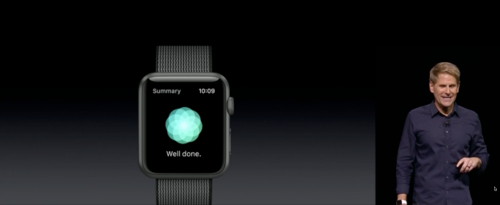
Jay Blahnik shows the Breathe app in action
It will be interesting to see if the Heartmath people take an interest in the use of the single colour mandala Apple is using, although it must be said these are quite common symbols especially if purchase fuel for you car:

British Petroleum logo bears a strong resemblance to many breathing app symbols
Interesting side bar:
I visited the HeartMath headquarters up in the Santa Cruz mountains after giving a Macworld workshop in San Francisco a couple of years after the first release of the iPhone, perhaps 2009.
I was there to discuss how better to bring the emWave and its technologies to Australians, and suggested that the iPhone platform opening up to external developers would be an ideal match for the emWave technologies.
Heartmath already had a rather simple but expensive portable device that could sync with its desktop software, and the senior management I spoke with were not interested in developing an app., citing costs. Of course, perhaps one was already in development under an NDA, because a few years later Heartmath released its InnerBalance app (see below) and hardware for the 30pin iPhone and iPad. That has now been upgraded to a lightning connection for the current iOS devices. Moreover, the Heartmath folk incorporated a cloud sharing function, such that a patient could record a breathing trial and give their therapist access to it, for further analysis and feedback in the next session.
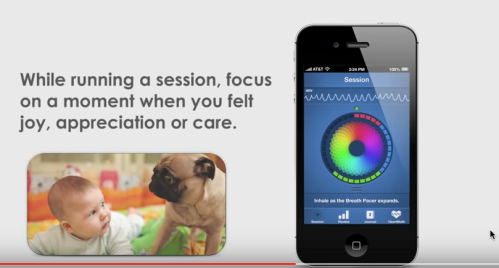
Heartmath.org Inner Balance app on the iPhone
One of the problems with the Heartmath system is its use of proprietary algorithms to measure a concept known as Coherence, which Heartmath claims to be a measure of balance between sympathetic and parasympathetic arousal.
It does incorporate an international standardised measure of something known as Heart Rate Variability (HRV), but rarely mentions this in its promotional literature. This is why most scholarly studies will use other systems to measure HRV, so measures can be replicated, the hallmark of scientific research.
In late 2014, perhaps aware that Apple’s focus on health and the then rumoured Applewatch rendered its platform threatened, Heartmath entered into an arrangement to license it proprietary algorithms to, of all companies, Samsung, plus one or two others, as shown in its media release, below (click to enlarge):
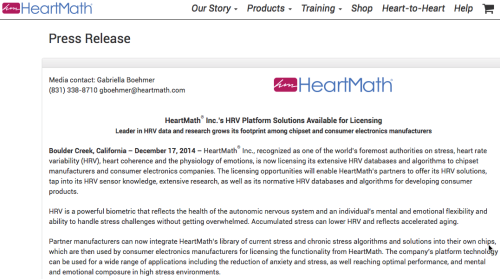
Heartmath announces the licensing of its proprietary algorithms for Heart Rate Variability
18 months later I’ve not yet seen signs of Samsung employing Heartmath’s technologies. Perhaps the Breathe app will cause some movement for Samsung.
The problem with many of these breathing apps
I want to return to a problem I have with some of these apps, including emWave, and that is that their pacing mandalas are symmetrical… you set the pace in and out and it is the same.
Yet there is now abundant research that there is an optimal breathing rate for each person and that is usually asymmetrical. I couldn’t see in the information so far available for the Breathe app where it can be adjusted but I am heartened by an interview I did see with Jay Blahnik from the UK Daily Mail of June 15, 2016:

Notice the acknowledgement of the longer exhales by Apple, but I don’t see any efforts to help users locate their optimal breathing rate via some external measure. It sets an optimal ratio of in to out (1:1.5) and an optimal breathing rate of 7 cycles per minute.
Let’s contrast that with the HeartRate+ app, which iTunes shows as having a pacer where you can see a yellow ball in the second panel:

Notice the second and fourth panels where you can set and experiment with breathing patterns
But notice the fourth panel, above. It is here you can set the timing for In, hold, out, hold…
It mimics a free standing Windows-only that’s been put out by the Biofeedback Foundation of Europe (BFE), known as Ez-Air Plus. It is Windows only (yeah, go figure), was free but is now USD19.95. Take a look at it in action on my Macbook Pro running Windows 7 in Parallels:
And if you search for “breath pacer” in the iTunes app store, you will find a number with varying degrees of user configuration, such as this one:
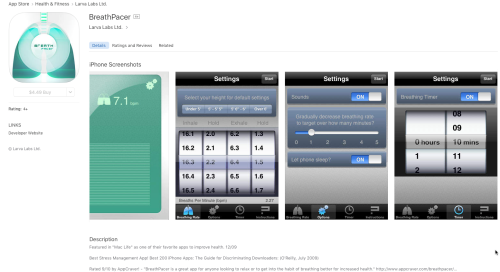
An inexpensive iOS app which allows you to configure various breathy pacing parameters
So Apple’s research has concluded that for most users, a breath cycle of 7/min is best. This may be true for the average person, but what about someone who is more challenged, and suffers considerable anxiety which is intrusive and worthy perhaps of a few sessions with a psychologist?
Introducing Respiratory Sinus Arrhythmia (RSA)
In this case, the task is to find out the best breathing pattern which yields the highest possible heart rate variability. To some extent this is trial and error, although a number of the pacing apps will take you through a series of changing patterns over the course of ten or so minutes to see which pattern is best. That pattern has a name, by the way. It is called Respiratory Sinus Arrhythmia (RSA), and represents the influence of respiration to cause a change in the firing of the Sino-Atrial (SA) node in the heart. When this node “fires” it causes the atria of the heart to contract, and the heartbeat cycle commences.
That node begins activating in the developing fetus causing its tiny heart to beat at around day 22 on its own.
Indeed, if you take a diseased heart out of a living person during the course of a heart transplant, it will continue to beat for about half an hour before it ceases:
The main physical link between the heart and the diaphragm is the tenth (X) cranial nerve, the Vagus, an element of the body’s Parasympathetic Nervous system. The Vagus also descends into the viscera (gut), and from the heart heads back into the brain. Some scholars suggest more information returns to the brain (afferent) than goes out (efferent). If you change the activity of one element of the body innervated by the Vagus nerve, the others on the same “train line”, so to speak, are also affected.
The Romans and the Greeks did a lot of the naming of the body’s elements, not so much about function, but about shape, and location. So one element of the threat system which is located in the limbic system is the Amygdala, ancient Greek for almond, due to its shape and size.
The Vagus is so named because, of the twelve cranial nerves named by the Romans, it’s the only one that leaves the head region to travel or wander through the body. Vagus is latin for “to wander”, and so if we say that someone’s conversation is hard to follow or is all over the place, they’re being vague. Sometimes we might say they’re being incoherent, or hard to follow or make a pattern of their speech, and you will see coherence as a measure in some of the HRV apps and devices.
What does this all mean for the anxious presenter?
In my sessions with anxious patients, the task as I see it is to assist them to wind back or recalibrate the threat or alarm system so they may bring focus and attention to the task at hand. This is not to help them “relax” or “feel calm”. Indeed, you can feel highly aroused, heart beating rapidly and deliver an inspired presentation. Just like “take a couple of deep breaths” may not be the best advice, nor is “try and be calm”.
In my work, calmness can be a byproduct or artefact of maximising HRV. Breathing exercises which are slow and deliberate involving the diaphragm cause increased vagal tone which can be measured by even inexpensive heart rate equipment. One asks patients to practise this breathing style on a daily basis, starting with just a few minutes, and perhaps once or twice a week for twenty minutes. Practise when you don’t need the intended effects while you’re still learning about how best to breathe to avoid disappointment. Such as after you send an email, when you come back to work after lunch, etc.
So this kind of app can find utility not just with anxiety, but anybody who needs to up their game, including elite sports people. This is where Apple needs to up its game. Raw heart rate alone is not a good measure of anxiety, although it is a reasonable one for arousal. HRV is much better for assessing vagal tone which can lead to better focus and attention to task. Despite the likely presence of discomforting sensations.
The Applewatch, by being able to measure heart rate, is half way there. All it needs is the open sourced international standards for HRV (PDF) to be applied in a user friendly way (gamification?) for the watch to be truly useful in stress management. As it stands, it’s not there yet, but it’s just a matter of time.
UPDATE – June 23, 2016. Reader Matthew Cassinelli tweeted me that in his use of the watchOS beta, there is an interface where you can dial in the breathing rate.

Apple’s watchOS allows its Breathe app to dial in the breathing rate
This shows that Apple is really thinking about this app and what is needed to individualise it for each user. I’m guessing that in an update there will be a routine by which you can detect which is your best breathing rate not just for comfort, but because it maximises your HRV. Perhaps it will allow you to start 10 breaths per minute, for a minute, then move each minute through one less cycle per minute, ie., 10…9…8… etc. and then give you feedback as to your optimum rate.



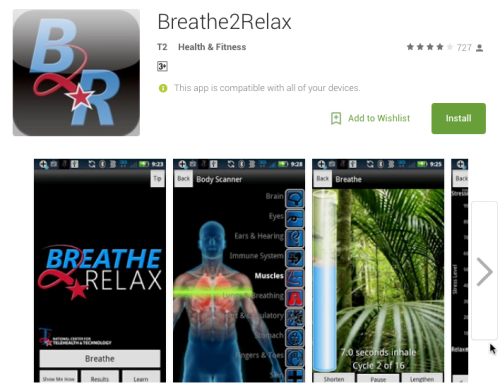

Pingback: Wiser Web Wednesday – Pete Denison
At last we have a new version of iWork. It looks good, but I’m still a little sad. Pages has not seen the return of linked text boxes. Keynote could use support for some sort of layers. The collaboration and Keynote Live features are very nice.
Question: what effect did Tim Cook use at the 24:15 mark in his presentation. Talking about Apple Watch he had a column of watch names with Apple Watch at the bottom. In the effect, Apple Watch bubbles up through these to the second row. I have the new version but can’t see a way to reproduce this.
Will,take a look and reply here.
I have a fuzzy feeling a major update is on its way…